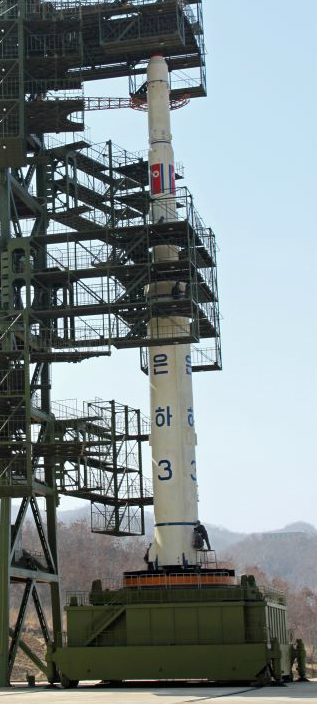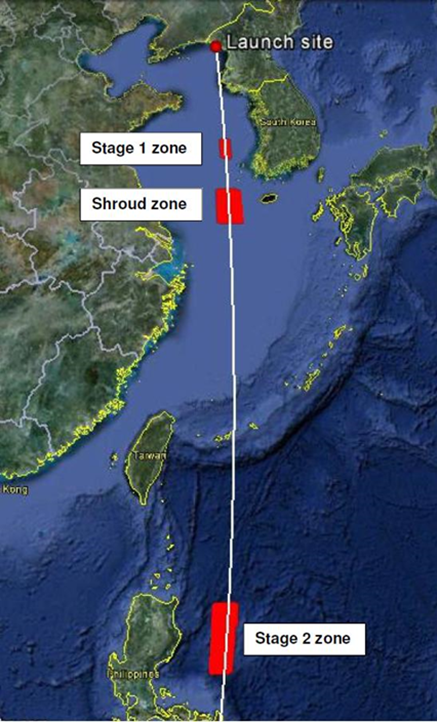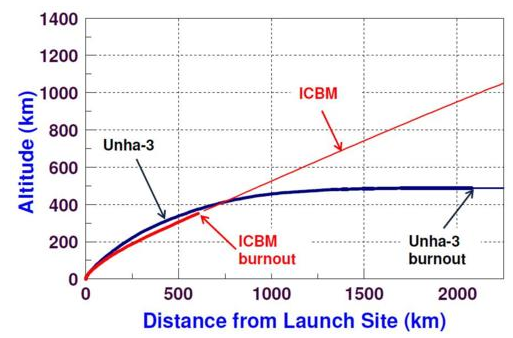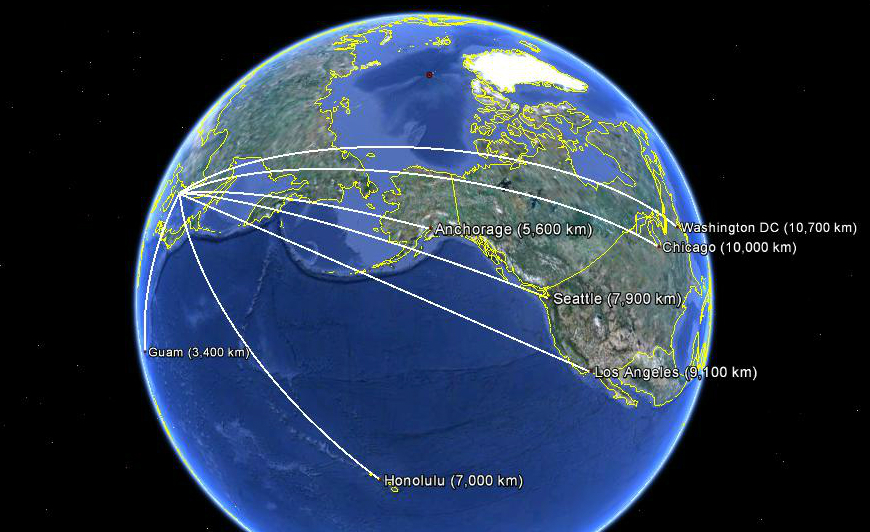Dr. David Wright on North Korea’s Satellite

Contents
Earlier this month, Dr. David Wright, co-director of the Union of Concerned Scientists Global Security Program, wrote two posts about North Korea’s satellite launch. While North Korea isn’t currently thought to pose an existential risk with their weapons, any time nuclear weapons are involved, the situation has the potential to quickly escalate to something that could be catastrophic to the future of humanity. We’re grateful to Wright and the UCS for allowing us to share his posts here.
North Korea is Launching a Rocket Soon: What Do We Know About It?
North Korea has announced that it will launch a rocket sometime in the next two weeks to put a satellite in orbit for the second time. What do we know about it, and how worried should we be?

Fig.1. The Unha-3 ready to launch in April 2012. (Source: Sungwon Baik / VOA)
What We Know
North Korea has been developing rockets—both satellite launchers and ballistic missiles—for more than 25 years. Developing rockets requires flight testing them in the atmosphere, and the United States has satellite-based sensors and ground-based radars that allow it to detect flight testing essentially worldwide. So despite North Korea being highly secretive, it can’t hide such tests, and we know what rockets it has flight tested.
North Korea’s military has short-range missiles that can reach most of South Korea, and a longer range missile—called Nodong in the West—that can reach parts of Japan. But it has yet to flight test any military missiles that can reach targets at a distance of greater than about 1,500 kilometers.
(It has two other ballistic missile designs—called the Musudan and KN-08 in the West—that it has exhibited in military parades on several occasions over the past few years, but has never flight tested. So we don’t know what their state of development is, but they can’t be considered operational without flight testing.)
North Korea’s Satellite launcher
North Korea has attempted 5 satellite launches, starting in 1998, with only one success—in December 2012. While that launch put a small satellite into space, the satellite was apparently tumbling and North Korea was never able to communicate with it.
The rocket that launched the satellite in 2012 is called the Unha-3 (Galaxy-3) (Fig. 1). North Korea has announced locations of the splashdown zones for its upcoming launch, where the rocket stages will fall into the sea; since these are very similar to the locations of the zones for its 2012 launch, that suggests the launcher will also be very similar (Fig. 2).

Fig. 2. The planned trajectory of the upcoming launch. (Source: D Wright in Google Earth)
We know a lot about the Unha-3 from analyzing previous launches, especially after South Korea fished parts of the rocket out of the sea after the 2012 launch. It is about 30 m tall, has a launch mass of about 90 tons, and consists of 3 stages that use liquid fuel. A key point is that the two large lower stages rely on 1960s-era
Scud-type engines and fuel, rather than the more advanced engines and fuel that countries such as Russia and China use. This is an important limitation on the capability of the rocket and suggests North Korea does not have access to, or has not mastered, more advanced technology.
(Some believe North Korea may have purchased a number of these more advanced engines from the Soviet Union. But it has never flight tested that technology, even in shorter range missiles.)
Because large rockets are highly complex technical systems, they are prone to failure. Just because North Korea was able to get everything to work in 2012, allowing it to orbit a satellite, that says very little about the reliability of the launcher, so it is unclear what the probability of a second successful launch is.
The Satellite
The satellite North Korea launched in 2012— the Kawngmyongsong-3, or “Bright Star 3”—is likely similar in size and capability (with a mass of about 100 kg) to the current satellite (also called Kawngmyongsong ). The satellite is not designed to do much, since the goal of early satellite launches is learning to communicate with the satellite. It may send back photos from a small camera on board, but these would be too low resolution (probably hundreds of meters) to be useful for spying.
In 2012, North Korea launched its satellite into a “sun-synchronous orbit” (with an inclination of 97.4 degrees), which is an orbit commonly used for satellites that monitor the earth, such as for environmental monitoring. Its orbital altitude was about 550 km, which is twice as high as the Space Station, but lower than most satellites, which sit in higher orbits since atmospheric drag at low altitudes will slow a satellite and cause it to fall from orbit sooner. For North Korea, the altitude was limited by the capability of its launcher. We expect a similar orbit this time, although if the launcher has been modified to carry somewhat more fuel it might be able to carry the satellite to a higher altitude.
The Launch Site and Flight Path
The launch will take place from the Sohae site near the western coast of North Korea (Fig. 2). It would be most efficient to launch due east so that the rocket gains speed from the rotation of the earth. North Korea launched its early flights in that direction but now launches south to avoid overflying Japan—threading the needle between South Korea, China, and the Philippines.
North Korea has modified the Sohae launch site since the 2012 launch. It has increased the height of the gantry that holds the rocket before launch, so that it can accommodate taller rockets, but I expect that extra height will not be needed for this rocket. It has also constructed a building on the launch pad that houses the rocket while it is being prepared for launch (which is a standard feature of modern launch sites around the world). This means we will not be able to watch the detailed launch preparations, which gave indications of the timing of the launch in 2012.
Satellite launch or ballistic missile?
So, is this really an attempt to launch a satellite, or could it be a ballistic missile launch in disguise? Can you tell the difference?

Fig. 3. Trajectories for a long-range ballistic missile (red) and Unha-3 satellite launch (blue).
The U.S. will likely have lots of sensors—on satellites, in the air, and on the ground and sea—watching the launch, and it will be able to quickly tell whether or not it is really a satellite launch because the trajectory of a satellite launch and ballistic missile are very different.
Figure 3 shows the early part of the trajectory of a typical liquid-fueled ballistic missile (ICBM) with a range of 12,000 km (red) and the Unha-3 launch trajectory from 2012 (blue). They differ in shape and in the length of time the rocket engines burn. In this example, the ICBM engines burn for 300 seconds and the Unha-3 engines burn for nearly twice that long. The ICBM gets up to high speed much faster and then goes much higher.
Interestingly, the Unha-3’s longer burn time means that its upper stages have been designed for use in a satellite launcher, rather than a ballistic missile. So this rocket looks more like a satellite launcher than a ballistic missile.
Long-Range Missile Capability?
Of course, North Korea can still learn a lot from satellite launches about the technology it can use to build a ballistic missile, since the two types of rockets use the same basic technology. That is the source of the concern about these launches.
The range of a missile is based on the technology used and other factors. Whether theUnha-3 could carry a nuclear warhead depends in part on how heavy a North Korea nuclear weapon is, which is a topic of ongoing debate. If the Unha were modified to carry a 1,000 kg warhead rather than a light satellite, the missile could have enough range to reach Alaska and possibly Hawaii, but might not be able to reach the continental U.S. (Fig. 4). If instead North Korea could reduce the warhead mass to around 500 kg, the missile would likely be able to reach large parts of the continental U.S.
North Korea has not flight tested a ballistic missile version of the Unha or a reentry heat shield that would be needed to protect the warhead as it reentered the atmosphere. Because of its large size, such a missile is unlikely to be mobile, and assembling and fueling it at the launch site would be difficult to hide. Its accuracy would likely be many kilometers.

Fig. 4: Distances from North Korea. (Source: D Wright in Google Earth)
The bottom line is that North Korea is developing the technology it could use to build a ballistic missile with intercontinental range. Today it is not clear that it has a system capable of doing so or a nuclear weapon that is small enough to be delivered on it. It has shown, however, the capability to continue to make progress on both fronts.
The U.S. approach to dealing with North Korea in recent years through continued sanctions has not been effective in stopping this progress. It’s time for the U.S. to try a different approach, including direct U.S.-Korean talks.
North Korea Successfully Puts Its Second Satellite in Orbit
North Korea launched earlier than expected, and successfully placed its second satellite into orbit.
The launch took place at 7:29 pm EST Saturday, Feb. 6, U.S. time, which was 8:59 am local time on Sunday in North Korea. It originally said its launch window would not start until Feb. 8. Apparently the rocket was ready and the weather was good for a launch.
The U.S. office that tracks objects in space, the Joint Space Operations Center (JSPOC), announced a couple hours later that it was tracking two objects in orbit—the satellite and the third stage of the launcher. The satellite was in a nearly circular orbit (466 x 501 km). The final stage maneuvered to put it in a nearly polar, sun-synchronous orbit, with an inclination of 97.5 degrees.
Because the satellite orbit and other details of the launch were similar to those of North Korea’s last launch, in December 2012, this implies that the launch vehicle was also very similar.
This post from December 2012 allows you to see the launch trajectory in 3D using Google Earth.
South Korea is reporting that after the first stage burned out and was dropped from the rocket, it exploded before reaching the sea. This may have been intended to prevent it from being recovered and studied, as was the first stage of its December 2012 launch.
The satellite, called the Kwangmyongsong-4, is likely very similar to the satellite launched three years ago. It will likely not be known for several days whether, unlike the 2012 satellite, it can stop tumbling in orbit and communicate with the ground. It is apparently intended to stay in orbit for about 4 years.
If it can communicate with the Kwangmyongsong-4, North Korea will learn about operating a satellite in space. Even if not, it gained experience with launching and learned more about the reliability of its rocket systems.
For more information about the launch, see my earlier post.
Note added: Feb. 7, 1:00 am
The two orbiting objects, the satellite and the third-stage rocket body, show up in the NORAD catalog of space objects as numbers 41332 for the satellite and 41333 for the rocket body. (Thanks to Jonathan McDowell for supplying these.)
About the Future of Life Institute
The Future of Life Institute (FLI) is a global think tank with a team of 20+ full-time staff operating across the US and Europe. FLI has been working to steer the development of transformative technologies towards benefitting life and away from extreme large-scale risks since its founding in 2014. Find out more about our mission or explore our work.
Related content
Other posts about Nuclear, Partner Orgs, Recent News

The U.S. Public Wants Regulation (or Prohibition) of Expert‑Level and Superhuman AI

Poll Shows Broad Popularity of CA SB1047 to Regulate AI

FLI Praises AI Whistleblowers While Calling for Stronger Protections and Regulation

